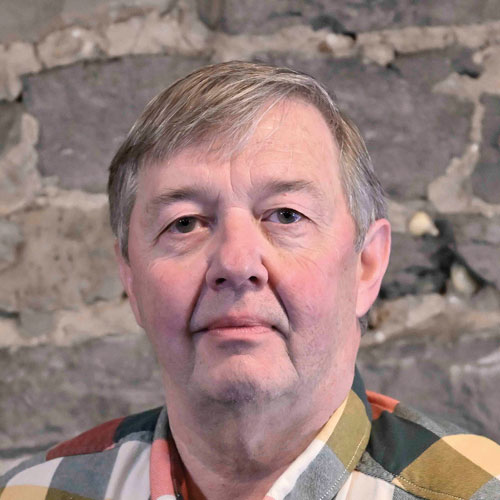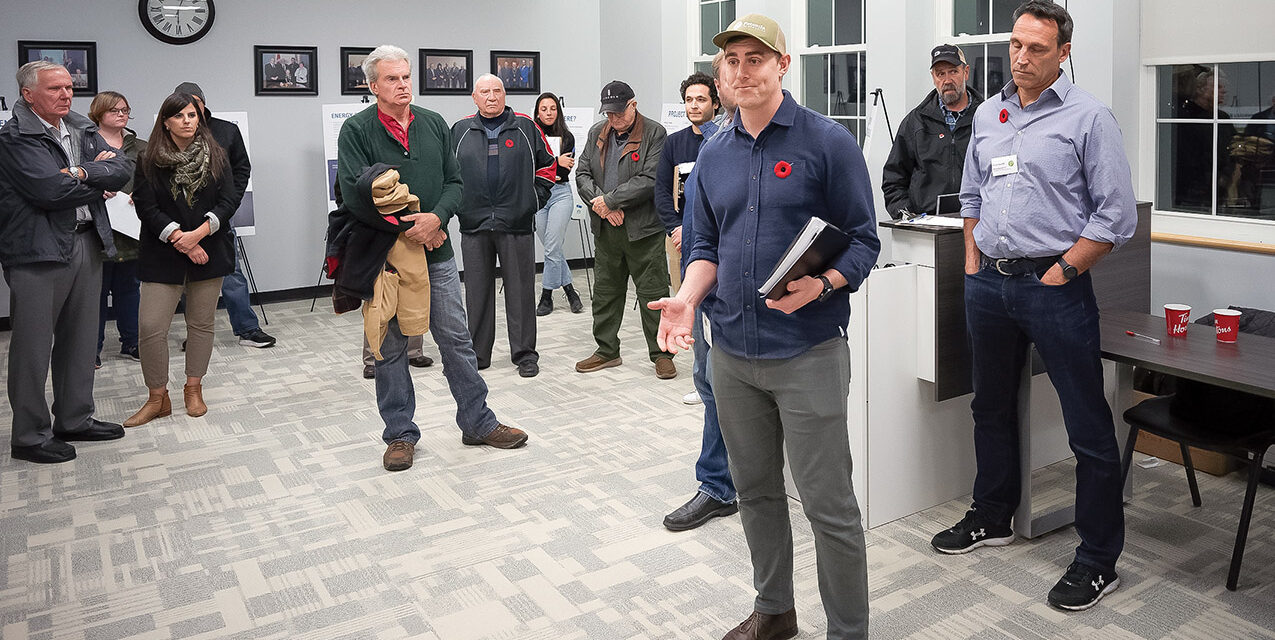Will Patterson. P.Eng., PMP, senior manager, project development for Potentia Renewables led the public information session for the BESS, which stands for Battery Energy Storage Project and is being proposed for Gilmour Road in South Dundas. Tinkess Photo
SOUTH DUNDAS – There is a new acronym to add to our vocabulary, and you had better get used to hearing it, because it will be a topic of discussion for some time to come.
The acronym is BESS, which stands for Battery Energy Storage Project, the official name for the lithium-ion electricity storage facilities that are being proposed for many locations throughout the province.
South Dundas is one area being considered, and as required, the proponent (company bidding to build and operate the facility) Creekside BESS Limited Partnership, hosted a public meeting on Wed., Nov. 8 at the South Dundas Municipal Building.
Officially, Creekside BESS Limited Partnership is a controlled subsidiary of PR Development LP, an affiliate of Potentia Renewables Inc. and they are bidding on the right to construct a lithium-ion battery storage facility on the north side of Gilmour Road, east of county road one. The project is sized to provide up to 230 megawatts over four hours (920 Megawatt-hours) and will be on a parcel of prime agricultural land (class four) of about 15 acres in size.
This, and similar projects across Ontario are being proposed because after a long period of strong electrical supply, the Independent Electricity System Operator (IESO) is projecting a period of significant electricity need due to economic and population growth, manufacturing electrification and the retirement of the Pickering Nuclear generating facility. It is anticipated that 4,000 megawatts of additional capacity will be required.
The purpose of this project and most if not all the others being proposed across the province is to store surplus electricity that is generated at times of low usage by existing infrastructure, so that it can be used at times of higher usage to meet the projected requirements indicated above. Currently, surplus electricity, that cannot be redistributed and used across Ontario’s portion of the grid, is exported to neighbouring provinces and states at prices that are lower than the cost of production, and on occasion, these other users are paid to accept it.
The presentation in South Dundas, led by Will Patterson. P.Eng., PMP, senior manager, project development for Potentia was very casual. Patterson told the group in attendance about the project and then opened the floor for questions. These, for the most part were well thought out, and respectful, people speaking with a stranger about something they had little or no previous knowledge about. The answers, unfortunately, did not have the amount of detail that most were seeking, but this was primarily because this project is very much at the early stages.
The public open houses are being held by the proponents, in this case Creekside, which will be bidding for the opportunity to begin the process of meeting all the permit and approval requirements necessary for a project of this scale. The procurement documents outlining the process can be found via a link from the company’s website (creeksideBESS.ca) in the second paragraph under Project Overview. They can also be found at https://www.ieso.ca/en/Sector-Participants/Resource-Acquisition-and-Contracts/Long-Term-RFP-and-Expedited-Process.
The proponent must be selected as a winning bidder to pursue the project. If the proponent cannot obtain all permit and approval requirements, it cannot complete the project. The tender process only allows the winning bidder the opportunity to continue the process and is in no way a guarantee of success.
The most common question seemed to surround the idea of fire and how it would be dealt with. Patterson offered some suggestions but confirmed that this is very much an early-stage proposal, but that more details would be forthcoming as the process progresses. The deadline for the submission of bids is Dec. 12 at 3:00 p.m. and the successful bids are to be announced in May 2024.
One person who asked more than a few questions was Sarah Burger who travelled from Ottawa to attend the meeting. She agreed that the whole concept of BESS seemed to have popped up overnight.
“I think they might have been in the works,” said Burger. “But it’s been very hard to access the information unless you know what you’re looking for. Like there’s ones that I like, because they go project by project on the websites. And some of them, for example, like the project near my house, it’s like if you knew the company, you go to the company but that didn’t have a direct link to their project website.
“I think it’s just a matter of public awareness, to be honest, like, if there’s some mechanism, where it’s like a central location, like a website or something, that would be my suggestion if they want to improve the public notification process.”
At the completion of the meeting, Patterson was asked if he had received the response he expected.
“I think so. I think we’re getting a lot of it because it’s a new project, it’s a new project in a rural area, and it’s a different technology than is common here,” said Patterson. “And I think anytime that happens, there’s lots of questions and we expect lots of questions. And that’s what’s happening, is we expect lots of questions, and we’re trying to respond with answers where we can, but where we can’t, we just tried to say that was a great question. And that’s something that is more maybe geared towards detailed design. Yeah, I think right now, we’ve done a lot of work to try to assign these in an area that would be acceptable to the community. And it’s good to get some initial feedback on that.”

Terry Tinkess is a professional photographer, educator and journalist. He has been making a living with a camera and keyboard since 1999 and has been featured in such publications as The Ottawa Citizen, Cornwall Standard Freeholder, The Globe and Mail, The Miami Herald, Ottawa Construction News, The Ontario Construction Report, Ontario Home Builder Magazine, Reed Construction Data, Canadian Potato Business and most recently, The Record and Eastern Ontario AgriNews. Terry lives in Ingleside, Ontario with his wife Brenda, Mia the anxious Pittie and cats Wally and Chubbers.









